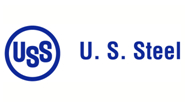Steel Mills

USS Shakes Off Price Drop, Sees Strong '22 Ahead
Written by Michael Cowden
January 28, 2022
U.S. Steel isn’t letting current lower prices get it down after a record year in ’21 and in anticipation of more good times rolling into ‘22.
The Pittsburgh-based steelmaker said it had expected the first quarter would be weaker but that such weakness would to be temporary.
![]() “Supply chain issues will ease, inflationary pressures will abate, saving rates remain high … and demand remains pent up for the markets we serve. This is a recipe for success in steel,” U.S. Steel President and CEO David Burritt said during an earnings conference call on Friday, Jan. 28.
“Supply chain issues will ease, inflationary pressures will abate, saving rates remain high … and demand remains pent up for the markets we serve. This is a recipe for success in steel,” U.S. Steel President and CEO David Burritt said during an earnings conference call on Friday, Jan. 28.
Burritt also addressed concerns about lower fourth quarter earnings versus the prior quarter and about lower steel prices.
“While the market is certainly looking for every reason to be negative about the prospects for this year, we remain overwhelmingly positive,” he said. “We know about the risks: the Fed taking rates up too fast, unexpected changes to import restrictions, geopolitical risk, existential risks. The risks are many. But we’ve seen it all before.”
Prices
It doesn’t hurt that steel prices are roughly double historic norms even following a big price correction, Burritt added.
Case in point: SMU’s average hot-rolled coil price is at $1,335 per ton ($66.75 per cwt), down a whopping $620 per ton from a 2021 high, recorded in September, of $1,955 per ton. That’s still more than double $610 per ton in January 2020 – a year that started out strong for steel before the COVID-19 pandemic outbreak hit.
“While markets continue to self-correct, the macro backdrop is favorable,” Burritt said. And lower prices aren’t without a silver lining. That in combination with shorter lead times means that interest in imports is “starting to fade.” European hot-rolled coil prices, meanwhile, have stabilized close to $1,000 per ton.
Also, supply chain bottlenecks and inflation should ease. And consumers have been saving, which means they have cash to spend on steel-intensive goods such as appliances and automobiles. “The thing that’s amazing with auto is just unfulfilled demand. The inventories are so low,” he said.
Automakers have been unable to keep pace with demand because of a variety of supply chain problems, an issue for which the global microchip shortage has become the posterchild. But as those supply chain snarls are untangled, demand for steel from the automotive sector will improve, Burritt predicted.
Another benefit of high prices in 2021: fixed-priced contracts with original equipment manufacturers (OEMs) in 2022 have reset higher. “Make no mistake, the success we had on fixed-price contracts has generated significant year-over-year uplift,” Burritt said.
Divestitures
U.S. Steel executives were also asked whether they were considering divesting any non-core assets.
Burritt noted the company had sold its Transtar railroad subsidiary – in a $640 million deal – last year. “We have a whole portfolio of things that we look at from time to time,” he added.
There have been rumors that U.S. Steel is looking to sell its USS-UPI LLC subsidiary in Pittsburg, Calif. Company executives did not mention UPI by name on the call.
“I’ll not get into any specifics, obviously, but there are always processes that we’re looking at,” Chief Strategy Officer Rich Fruehauf said. “As we say, everything is for sale at the right price.”
By Michael Cowden, Michael@SteelMarketUpdate.com

Michael Cowden
Read more from Michael CowdenLatest in Steel Mills

Algoma fires up EAF steelmaking with first arc
Algoma Steel reached a milestone in its transformation from blast furnace to electric arc furnace (EAF) steelmaking, with its Unit One EAF achieving its first steel production this week.

Nucor holds HR list price at $910/ton
Nucor is keeping its list price for spot hot-rolled coil unchanged after last week’s shortened holiday week.

Cliffs unveils new hydrogen-powered stainless line in Ohio
CEO Lourenco Goncalves, flanked by state leaders and union reps, touted the project as proof that US manufacturing is not only alive, but also advancing.

Cliffs idles Steelton, Riverdale, and Conshohocken operations
Cliffs has idled facilities in Riverdale, Ill., and Conshohocken and Steelton, Pa.

Radius loss narrows, volumes climb in ‘healthy’ West Coast market
Stronger steel demand in the Western US, rising scrap flows, and improved rolling mill utilization drove sequential gains for Portland, Ore.-based Radius Recycling.
